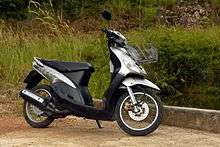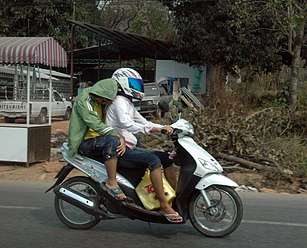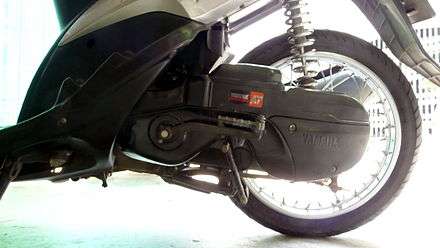Yamaha Mio
The Yamaha Mio is a scooter with a CVT transmission made by Yamaha Motor. It was introduced for the Southeast Asia market in 2003 as the successor of the Nouvo. In Malaysia, this model is known as Yamaha Ego. As 2007, there were some 76,000 Ego customers in Malaysia.[1] Together with its counterpart the Yamaha Nouvo, the Mio/Ego is a platform for customization in Thailand, Malaysia, Vietnam and the Philippines.
 Yamaha Mio Z | |
| Manufacturer | Yamaha Motor Co., Ltd. |
|---|---|
| Also called | Yamaha Ego (Malaysia) |
| Production | 2003-present |
| Class | Scooter |
| Engine | 113.7 cc (115), 4-stroke, SOHC, 2 valve, air cooled (124.8 cc (125), 4-stroke, SOHC, 2 valve, air cooled) |
| Power | Carburetor 5.98kW (8.9 PS)@ 12,000 rpm
Fuel injected 7,75 ps @ 8,500 rpm 125 version 7.0kW (9.5 PS)@ 8,500 rpm |
| Torque | Carburetor 7.53Nm @ 7000 rpm
Fuel injected 8,5Nm @ 5000 rpm 125 version 9.6Nm @ 5,500 rpm |
| Transmission | CVT |
| Suspension |
|
| Brakes |
|
| Weight | 87 kg (192 lb) (dry) 90 kg (200 lb) (wet) |
| Related | |
Model history
2003
Based on sales performance and also technical studies of its predecessor Yamaha Nouvo by Yamaha's R&D team, in 2003 Yamaha Motor successfully developed and marketed Yamaha Mio in Southeast Asia countries and in March 2004, Hong Leong Yamaha (HLY) introduced this model in Malaysia, renaming it Yamaha Ego.[2]
2006
2006 brought some new changes to the Mio. It was renamed and since then has been known as the Yamaha Mio Soul (except for the Malaysian market).
Physical change also can be seen in the 2006 model specifications. This includes an aggressive facelift by the Yamaha team: it features newly design V-shape headlight for better vision range at night and new body stripes. The engine, however, remained the same as in the 2003 model. For safety concerns, the taillight was re-designed with the addition of a retroreflector device.
For the Malaysian market, HLY again renamed the scooter as the Yamaha Ego S (S for Sport) and launched it in October 2007. The launch ceremony took place at the Sheraton Subang Hotel in Kuala Lumpur, Malaysia.[3]
2012
2012 changed from carburetor to fuel injected with big pulley cvt, with DiaSil cylinder and forged piston to reduce weight engine.
2014
2014 all changed engine large size 125cc use biggest size pulley and short range belt cvt make constantly speed and easy acceleration in uphill. DiaSil cylinder engine with forged piston and light structure body reduce weight, this scooter different fuel savings previous version.
Philippine market
All Yamaha Mios are produced by Yamaha Motor Philippines.
- Mio Soul MX, its only release was in 2009
- Mio Soul, Mio Soul i 115 and Mio Soul i 125
- Mio i 125
- Mio MX 125 and 125 MXi
- Mio Sporty and Amore Limited Edition
- Mio Aerox 155
- Mio Gravis (FreeGo)
"i" = fuel injected
Indonesian market
All Yamaha old and new range are produced by Yamaha Motor Indonesia Manufacturing.
- Mio 115
- Mio Soul, Soul GT 115 and Soul GT 125
- Mio J 115
- Mio GT 115
- Mio M3 125
- Mio S 125
- Mio Z 125
- XRIDE 115 and XRIDE 125 (semi adventure)
- Mio Fino 125
- XEON RC and XEON GT
- FreeGo (12 inch tyre based mio m3 engine)
- Mio Amore (Sporty) Limited Edition
Malaysian market
All Yamaha Ego old and new range are produced by Hong Leong Yamaha Motor Sdn. Bhd. (HLY).
- Ego 115cc (2004-2008)
- Ego S 115cc (2007-2011)
- Ego S Fi/Injection (YMjet-Fi)
- Ego LC 125cc
- Ego Avantiz 125cc (2017-Present)
- Ego Solariz 125cc (2017-Present)
Other markets
- Yamaha Mio Ultimo
- Yamaha Luvias
- Yamaha Mio ZR
- Yamaha Neo 125
- Yamaha GT 125
Gallery
 Yamaha Mio Ultimo
Yamaha Mio Ultimo Yamaha Mio ZR
Yamaha Mio ZR Yamaha Mio rear suspension
Yamaha Mio rear suspension
See also
References
- "Yamaha targets 38% share in m-cycle market". The Star Online. October 11, 2007. Retrieved 2008-08-01.
- "Ego Launch". Hong Leong Industries. March 10, 2004. Retrieved 2008-07-30.
- "Ego S Launch" (PDF). Hong Leong Yamaha. October 10, 2007. Retrieved 2008-07-30.
External links
| Wikimedia Commons has media related to Yamaha Mio. |
- Official website (in Japanese and English)